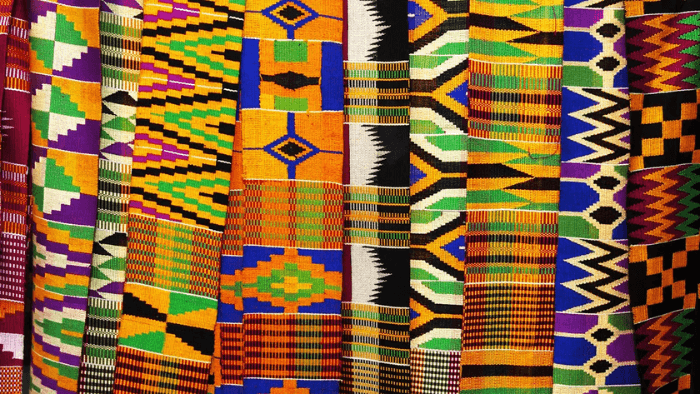Woven rights: Kente’s voice finds protection – what Nigeria must do next
On the outskirts of Bonwire, Kumasi, old weaver Mama Kofi folds a strip of vibrant Kente over her shoulder – midnight blue, gold, black zigzags, stitched with stories her mother taught her.
For decades, buyers offered lower and lower prices, telling her, “just add ‘Ghana-style’” before selling abroad. She knew those copies could never carry the weight of the loom, the dye, the hand.
Then, September 30, 2025, came. At the La-Palm Royal Beach Hotel in Accra, among Ghanaian officials, Kente artisans, musical interludes, and craftspeople, the Registrar-General’s Department, with the World Intellectual Property Organisation (WIPO), declared Ghana’s iconic cloth the country’s first-ever Geographical Indication (GI) product.
Mama Kofi heard her loom’s voice recognised. From this point on, only the cloth woven in designated Ghanaian communities by traditional methods can be sold globally as authentic “Kente.” Taglines like “Kente-style” or “Kente lookalike” won’t legally carry the weight of origin any more.
This wasn’t just a legal declaration. It was a reclaiming of heritage, identity, and economics for voices long unheard. But its ripples reach far beyond Bonwire – across borders, across looms, and across Nigeria’s textile heartlands.
Why This Matters: The Kente GI Equation
Authenticity & Reputation
A GI is more than words. It is intellectual property tied to place. It forbids misuse of the name “Kente” for fabric not made in the eligible weaving communities in Ashanti and Volta using specified techniques. This ensures buyers globally can trust what they are buying.
Brand Value & Economic Upside
With legal protection, weavers can command better prices. The recognition elevates Kente from “pretty cloth” to premium heritage good. Ghana’s weaving communities, numbering thousands (estimates vary, but Bonwire alone has hundreds of weaving families), now stand to benefit from both export markets and tourism.
Cultural Guardrails for Future Generations
The GI move safeguards not just fabric, but a lineage: how colours are chosen, motifs designed, weaving methods preserved. It ensures that Kente remains more than a costume for events; it remains a living heritage.
Nigeria’s Looms, Nigeria’s Losses
While Ghana acts, Nigeria’s textile crisis deepens. Some numbers:
Textile import bills skyrocketed to ₦726.18 billion in 2024, a 297.8% increase over 2020’s ₦182.5 billion.
Export growth in Nigerian textile articles did happen – from ₦6.022 billion in 2020 to ₦36.981 billion in 2024. Yet this pales beside the import flood and is heavily driven by currency depreciation rather than structural competitiveness.
The textile industry’s contribution to GDP is shrinking, and many mills have shut down. From over 180 textile mills some years ago, only about 20 remain active.
Under AGOA (African Growth and Opportunity Act), Nigeria’s textile and apparel exports to the U.S. amount to $548,000 (2023) – about 0.01% of total apparel imports under AGOA.
Tall numbers. But behind them are women like Mama Kofi, weavers, dye pits, looms silent, traditions fading. Many young people leaving the craft.
Read also: Dressed in imports: The irony of Nigeria’s traditional attire
What Nigeria Can Learn / Do
Ghana’s Kente GI is a live template. Here’s what Nigeria can do – not someday, but now:
Pass GI-]Specific Legislation for Textiles & Crafts
Nigeria needs a sui generis GI law or amend existing IP laws to explicitly cover fabrics, traditional textiles, handlooms, dye works, motifs.
Map Origins and Code of Practice
Identify weaving regions (Iseyin for Aso-Oke, Abeokuta for Adire, etc.), document weaving techniques, materials, motifs. Create “books of specifications” like Ghana did for Kente.
Empower Weaver Associations & Clusters
Local associations, craft guilds, state textile councils must be equipped to own GI processes: apply for protection, enforce use, educate members.
Protect Authenticity Legally and Commercially
Once GI status is secured, misuse (fake fabrics, “Kente-style”, “Aso-Oke inspired”) must be actionable. Use customs, IP offices, standards bodies to enforce.
Brand & Market Nigerian Textiles Globally
Use heritage, craftsmanship, origin story to build premium brands. Export, tourism, designer collaborations can project Nigerian cloths as luxuries.
Plug the Economic Leaks
Reduce import dependency, value addition at home, better export infrastructure. Nigeria needs to reverse trends: textile import growth is up ~300% over 5 years; exports up, yes, but still tiny. GI protection for key fabrics can shift this balance.
Portrait of Possibility
Imagine a world with these scenes:
A government-certified “Authentic Aso-Oke” label worn by fashion influencers in Paris.
Tourists visiting weaving villages in Oyo, seeing dye pits and looms, buying directly from artisans.
Aso-Oke, Adire, Hausa weaves being exported under protected origin labels, commanding premium prices.
Nigerian designers, weaving communities, textile clusters celebrating authenticity, income rising, traditions breathing again.
Closing: Looms Reclaimed, Identity Insured
Mama Kofi takes her cloth off the loom. She holds it up – the colours deep, the pattern sharp. Shadows of imposter fabrics won’t fool the eyes anymore. With GI protection, her weave is hers alone.
Ghana’s Kente GI signals that fabric is law, heritage is economics, identity is global currency. Nigeria has everything it needs – fibre, hands, colours, stories. It just needs the courage to codify, protect, and tell.
The loom sings; the cloth carries stories. When Nigeria claims its fabrics, it claims its narrative – and its place among nations that weave heritage into prosperity.

